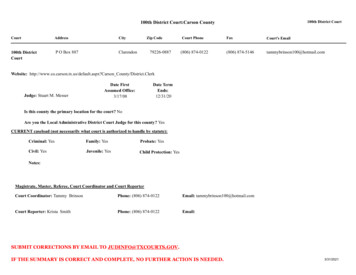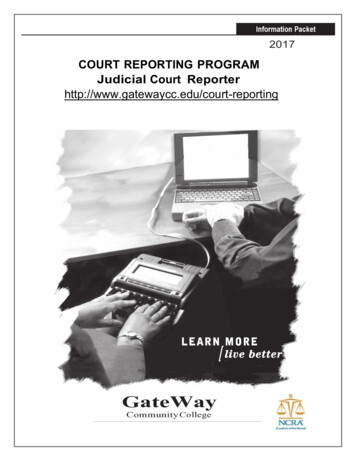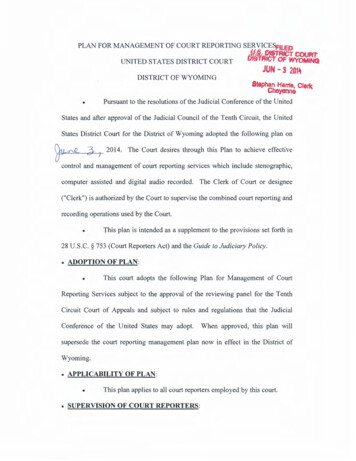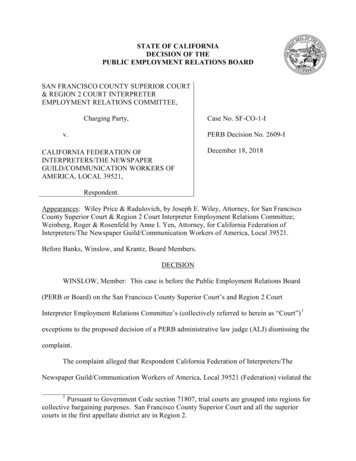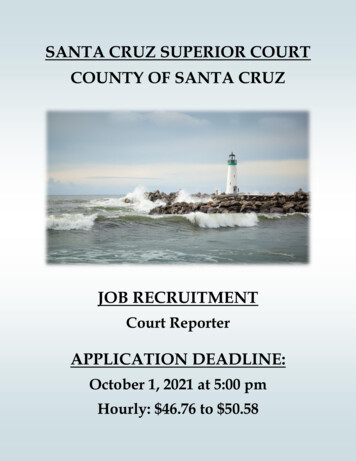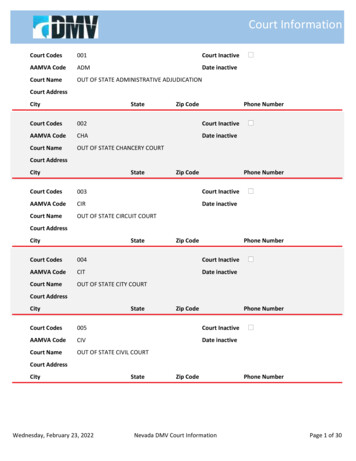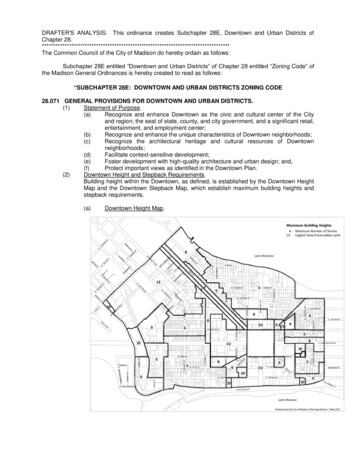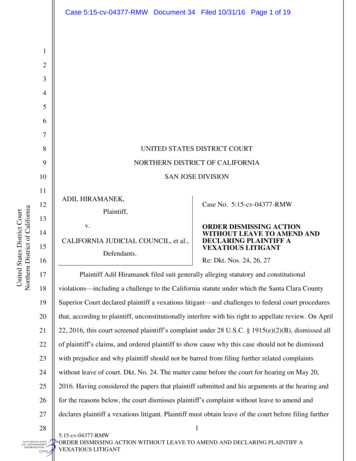
Transcription
Case 5:15-cv-04377-RMW Document 34 Filed 10/31/16 Page 1 of 1912345678UNITED STATES DISTRICT COURT9NORTHERN DISTRICT OF CALIFORNIA10SAN JOSE DIVISIONUnited States District CourtNorthern District of California1112ADIL HIRAMANEK,Case No. 5:15-cv-04377-RMWPlaintiff,13v.ORDER DISMISSING ACTIONWITHOUT LEAVE TO AMEND ANDDECLARING PLAINTIFF AVEXATIOUS LITIGANT1415CALIFORNIA JUDICIAL COUNCIL, et al.,Defendants.Re: Dkt. Nos. 24, 26, 271617Plaintiff Adil Hiramanek filed suit generally alleging statutory and constitutional18violations—including a challenge to the California statute under which the Santa Clara County19Superior Court declared plaintiff a vexatious litigant—and challenges to federal court procedures20that, according to plaintiff, unconstitutionally interfere with his right to appellate review. On April2122, 2016, this court screened plaintiff’s complaint under 28 U.S.C. § 1915(e)(2)(B), dismissed all22of plaintiff’s claims, and ordered plaintiff to show cause why this case should not be dismissed23with prejudice and why plaintiff should not be barred from filing further related complaints24without leave of court. Dkt. No. 24. The matter came before the court for hearing on May 20,252016. Having considered the papers that plaintiff submitted and his arguments at the hearing and26for the reasons below, the court dismisses plaintiff’s complaint without leave to amend and27declares plaintiff a vexatious litigant. Plaintiff must obtain leave of the court before filing further2815:15-cv-04377-RMWORDER DISMISSING ACTION WITHOUT LEAVE TO AMEND AND DECLARING PLAINTIFF AVEXATIOUS LITIGANT
Case 5:15-cv-04377-RMW Document 34 Filed 10/31/16 Page 2 of 191actions in this court against state or federal courts, their judges, their employees, and the United2States and its officials, with respect to the claims asserted in plaintiff’s complaint or substantially3similar claims.4I.Plaintiff’s complaint names numerous state and federal officials as defendants.1 Plaintiff’s5United States District CourtNorthern District of CaliforniaBACKGROUND6claims arise from plaintiff’s involvement in multiple state court cases and at least one federal case.7One of the key conflicts plaintiff experienced with the California courts occurred during a marital8dissolution proceeding initiated by plaintiff’s ex-wife in the Santa Clara County Superior Court,9Case No. 1-09-FL-149682. See Dkt. No. 1 (“Compl.”) ¶¶ 121, 323. During that case, the family10law judge allegedly issued a restraining order against plaintiff preventing plaintiff from having11access to his children for fifty years. Id. ¶¶ 130, 314. The family law judge also deemed plaintiff a12vexatious litigant under state law. Id. ¶ 124. Plaintiff was also involved in criminal proceedings in13state court. Plaintiff pled guilty to a misdemeanor charge to avoid felony charges of forgery and14identity theft. Id. ¶ 127. Plaintiff has apparently appealed this conviction on the grounds that the15plea agreement was involuntary. Id. ¶ 127 n.27. Plaintiff’s complaint mentions plaintiff’s16involvement in other state court cases as well. See, e.g., id. ¶ 155. Plaintiff is currently involved in17at least one other federal case against state court employees, Case No. 5:13-cv-00228-RMW,18pending in this court. Id. ¶ 151.19II.ANALYSIS20A.21The court’s April 22, 2016 order to show cause indicated that plaintiff could file a writtenMotion to File Excess Pages222324252627281The named defendants are: (1) The California Judicial Council; (2) Martin Hoshino, the JudicialCouncil’s Administrative Director; (3) California licensed court reporters Georgeann M. Wiles,Stacie Antonio, Melissa Crawford, and Graciela Miramontes; (4) The California Sixth DistrictCourt of Appeal, its Presiding Justice Conrad Rushing, and its employees Daniel Potter and ScottNasson; (5) The California First District Court of Appeal; (6) The California Supreme Court; (7)Tani Cantil-Sakauye, Chief Justice of California and Director of the California Judicial Council;(8) Steven Jahr, Administrative Director of the California Courts; (9) The United States ofAmerica; (10) Sidney Thomas, Chief Judge of the U.S. Court of Appeals for the Ninth Circuit; and(11) Loretta Lynch, the United States Attorney General.25:15-cv-04377-RMWORDER DISMISSING ACTION WITHOUT LEAVE TO AMEND AND DECLARING PLAINTIFF AVEXATIOUS LITIGANT
United States District CourtNorthern District of CaliforniaCase 5:15-cv-04377-RMW Document 34 Filed 10/31/16 Page 3 of 191response by May 6, 2016, not to exceed 25 double-spaced pages, addressing: (1) why the2complaint should not be dismissed with prejudice in its entirety for failure to state a claim; and (2)3why plaintiff should not be declared a vexatious litigant and barred from filing similar actions4without pre-filing review. On May 6, 2016, plaintiff filed a motion to exceed this page limit. Dkt.5No. 26. Plaintiff claims, without citation to any authority, that he was entitled to file two 25-page6responses to the court’s 18-page order to show cause—one for each topic above. Without waiting7for a response to his motion, plaintiff filed a 37-page response to the order to show cause, Dkt. No.827, along with 7 pages of additional objections to the order, Dkt. No. 27-2, and hundreds of pages9of supporting attachments, Dkt. Nos. 27-3 to 27-7. Plaintiff’s interpretation of this court’s order,10which cited the 25-page limit imposed by Civil Local Rule 7-4(b), is unreasonable and supports11this court’s finding that plaintiff is a vexatious litigant. The court nevertheless will consider the12arguments in plaintiff’s written submissions.13B.14This court’s April 22, 2016 order screened plaintiff’s complaint under 28 U.S.C.15§ 1915(e)(2)(B), dismissed all of plaintiff’s claims, and ordered plaintiff to show cause why this16case should not be dismissed with prejudice and without leave to amend. Dkt. No. 24.17Dismissal Without Leave to AmendUnder Rule 15(a) of the Federal Rules of Civil Procedure, leave to amend “should be18freely granted when justice so requires.” Lopez v. Smith, 203 F.3d 1122, 1127 (9th Cir. 2000) (en19banc) (internal quotation marks omitted). Nonetheless, a court “may exercise its discretion to deny20leave to amend due to ‘undue delay, bad faith or dilatory motive on part of the movant, repeated21failure to cure deficiencies by amendments previously allowed, undue prejudice to the opposing22party . . . , [and] futility of amendment.’” Carvalho v. Equifax Info. Servs., LLC, 629 F.3d 876,23892–93 (9th Cir. 2010) (quoting Foman v. Davis, 371 U.S. 178, 182 (1962)) (alterations in24original).25Plaintiff filed a written response to the order to show cause on May 6, 2016. Dkt. No. 27.26Plaintiff also filed a proposed addendum to his complaint, Dkt. No. 27-1, but the proposed27addendum amends only Claim 6 of the complaint regarding the court reporters, not the other five2835:15-cv-04377-RMWORDER DISMISSING ACTION WITHOUT LEAVE TO AMEND AND DECLARING PLAINTIFF AVEXATIOUS LITIGANT
Case 5:15-cv-04377-RMW Document 34 Filed 10/31/16 Page 4 of 191231.Americans with Disabilities Act (“ADA”) and Related ClaimsClaim 1 of the complaint is directed against California’s Supreme Court, First District4Court of Appeal, Sixth District Court of Appeal, Judicial Council, and Chief Justice Cantil-5Sakauye (in her “official capacity”) and alleges that the court defendants denied plaintiff various6disability accommodations including requests for telephonic appearances and electronic filing.7Plaintiff’s only specific alleged disability that this court was able to identify in the complaint is8plaintiff’s need to keep his foot elevated. See Compl. ¶¶ 24, 26, 28.9United States District CourtNorthern District of Californiaclaims. This order addresses each claim in plaintiff’s complaint.This court’s April 22, 2016 order provided multiple, independent reasons why Claim 1 of10plaintiff’s complaint failed to state a claim on which relief can be granted. Dkt. No. 24 at 5-8. In11response, as noted above, plaintiff filed a 37-page responsive brief and a 12-page proposed12addendum to Claim 6 (but not Claim 1) of the complaint, and plaintiff presented oral argument.13While plaintiff’s responses address some of the court’s reasons for dismissal, plaintiff still fails to14explain why plaintiff’s alleged disabilities prevented him from being able to appear personally in15court or use the state courts’ existing filing mechanisms. Plaintiff thus fails to explain how16plaintiff suffered unlawful treatment—or any harm at all—due to his disability.17Plaintiff’s continued failure to explain how his alleged disabilities prevented him from18accessing the state courts is fatal to his claim. As noted in this court’s April 22, 2016 order, in19another pending ADA case in which Hiramanek asserted a nearly identical claim, this court ruled20on summary judgment that the Superior Court of California, County of Santa Clara did not violate21the ADA by denying plaintiff’s requests for telephonic appearances or by refusing to allow22electronic filing, despite the fact that his disability required him to keep his foot elevated.23Hiramanek v. Clark, No. 5:13-CV-00228-RMW, 2016 WL 687974, at *10-11 (N.D. Cal. Feb. 19,242016) (Dkt. No. 546). Because the Superior Court was wheelchair accessible and allowed filings25by mail, this court ruled, plaintiff failed to meet his burden of showing that the accommodations26offered by the Superior Court were unreasonable in light of his disabilities. Id. In the instant case,27Hiramanek has not alleged that the state appellate or supreme courthouses are not wheelchair2845:15-cv-04377-RMWORDER DISMISSING ACTION WITHOUT LEAVE TO AMEND AND DECLARING PLAINTIFF AVEXATIOUS LITIGANT
United States District CourtNorthern District of CaliforniaCase 5:15-cv-04377-RMW Document 34 Filed 10/31/16 Page 5 of 191accessible. Nor has plaintiff explained how defendants’ existing filing mechanisms are insufficient2to accommodate his alleged disabilities. Moreover, plaintiff has not indicated in his responsive3brief, in his proposed addendum to the complaint, or at oral argument that he could make such4factual allegations if allowed leave to amend. The court concludes that allowing plaintiff to amend5would be futile.6Plaintiff argues that he does not have the burden to allege that the accommodations7requested were necessary to avoid discrimination on the basis of his disabilities, Dkt. No. 27 at 2,8but plaintiff’s argument is inconsistent with the plain text of federal regulations and with Ninth9Circuit law. See 28 C.F.R. § 35.130(b)(7) (“A public entity shall make reasonable modifications in10policies, practices, or procedures when the modifications are necessary to avoid discrimination on11the basis of disability, unless the public entity can demonstrate that making the modifications12would fundamentally alter the nature of the service, program, or activity.”) (emphasis added);13Memmer v. Marin Cty. Courts, 169 F.3d 630, 634 (9th Cir. 1999) (“Because Memmer bears the14burden of proof, she must show how the accommodations offered by [defendant] were not15reasonable.”); Duvall v. County of Kitsap, 260 F.3d 1124 (9th Cir. 2001) (“To prevail under the16ADA, Duvall must show that the accommodations offered by the County were not reasonable, and17that he was unable to participate equally in the proceedings at issue.”).18Furthermore, the court concludes that allowing plaintiff leave to amend to describe19additional alleged disabilities would be futile. Plaintiff claims that he has unspecified disabilities20in addition to the alleged foot injury described in his complaint, but plaintiff’s submissions do not21describe what these alleged disabilities are or explain why they prevented him from accessing the22defendant state courts.2 See Dkt. No. 27 at 3-4. If plaintiff were able to allege the existence of23other disabilities, he could have described those disabilities in his proposed addendum to the24complaint, Dkt. No. 27-1, and, to the extent plaintiff is concerned about medical privacy, plaintiff252627282To the extent that plaintiff claims that the undersigned judge is already aware of plaintiff’s otheralleged disabilities from proceedings in another case, plaintiff is improperly relying on evidenceoutside of the pleadings in this case.55:15-cv-04377-RMWORDER DISMISSING ACTION WITHOUT LEAVE TO AMEND AND DECLARING PLAINTIFF AVEXATIOUS LITIGANT
Case 5:15-cv-04377-RMW Document 34 Filed 10/31/16 Page 6 of 191United States District CourtNorthern District of California2could have moved to file his proposed amendments under seal. Plaintiff failed to do so.Moreover, plaintiff’s failure to explain how denials of telephonic appearances or electronic3filing harmed him suggests that plaintiff does not have standing to pursue his claims. Standing4under Article III of the U.S. Constitution requires: (1) “injury in fact—an invasion of a legally5protected interest which is (a) concrete and particularized and (b) actual or imminent, not6conjectural or hypothetical”; (2) causation—“there must be a causal connection between the injury7and the conduct complained of”; and (3) redressability—“it must be likely, as opposed to merely8speculative, that the injury will be redressed by a favorable decision.” Lujan v. Defenders of9Wildlife, 504 U.S. 555, 560–61 (1992) (internal quotation marks, citations and footnote omitted).10During oral argument, plaintiff struggled to remember what he was even trying to accomplish in11the lawsuits in which the defendant courts allegedly denied his requests to appear telephonically.12Claim 1 of plaintiff’s complaint seeks damages “estimated at no less than 9,999,999,” plus13“exemplary damages.” Compl. ¶ 69.x. Plaintiff has not plead or otherwise explained any facts to14suggest that the defendants’ alleged denials of his ADA requests caused plaintiff millions of15dollars in harm. This suggests bad faith on plaintiff’s part. Nor has plaintiff explained how a16favorable outcome in this case would remedy the harm he allegedly suffered.17Because plaintiff has failed to state a claim or allege sufficient facts to indicate that he has18standing, this order need not address plaintiff’s other arguments. Plaintiff has not explained how19amendment would cure these deficiencies. Accordingly, Claim 1 of plaintiff’s complaint is20dismissed without leave to amend.212.Civil Rights and Obstruction of Justice Claims22This court dismissed Claim 2 of plaintiff’s complaint against Justice Rushing and Court of23Appeal employees Nasson and Potter because the complaint failed to adequately place defendants24on notice of the allegations against them and because defendants were likely entitled to Eleventh25Amendment and/or judicial immunity. See Dkt. No. 24 at 8-9. Plaintiff’s written response does not26even attempt to address the fact that Claim 2 fails to state a claim because it lists more than thirty27different subsections of the United States Code, California statutes, and the U.S. and California2865:15-cv-04377-RMWORDER DISMISSING ACTION WITHOUT LEAVE TO AMEND AND DECLARING PLAINTIFF AVEXATIOUS LITIGANT
Case 5:15-cv-04377-RMW Document 34 Filed 10/31/16 Page 7 of 191constitutions, most of which bear no relation to the recited factual allegations. Plaintiff’s written2submissions make no attempt to explain his claim against each defendant in a way that would3provide adequate notice of the allegations against them.Nor does plaintiff cite any Ninth Circuit authority for the proposition that judicial or quasi-United States District CourtNorthern District of California45judicial immunity does not apply to court staff who refuse to accept filings. In directly analogous6cases, the Ninth Circuit has held that judicial or quasi-judicial immunity applies. See Mullis v. U.S.7Bankr. Court for Dist. of Nevada, 828 F.2d 1385, 1390 (9th Cir. 1987) (finding that court clerks8who allegedly refused to accept an amended petition were entitled to “absolute quasi-judicial9immunity” because they “perform[ed] tasks that are an integral part of the judicial process.”);10Sedgwick v. United States, 265 F. App’x 567 (9th Cir. 2008) (affirming decision that court clerk11who refused to file premature petition was entitled to absolute quasi-judicial immunity against due12process claims).While plaintiff cites Duvall v. County of Kitsap in support of his argument that judicial or1314quasi-judicial immunity should not apply, the portion of the case that Hiramanek cites involved an15ADA coordinator who refused to allow Duvall to use a videotext display, not a clerk who refused16to accept a filing.3 See Duvall v. County of Kitsap, 260 F.3d 1124, 1133-35 (9th Cir. 2001). In any17event, while the Duvall court found that material issues of fact precluded summary judgment in18favor of the ADA coordinator, the Duvall court also affirmed the lower court’s decision that19judicial immunity precluded claims against the presiding judge. 260 F.3d at 1133. To the extent20that plaintiff attempts to distinguish Justice Rushing from the judge in Duvall by arguing that that21plaintiff is suing Justice Rushing only in his administrative capacity, other courts have found that22judicial immunity applies even when a judge did not personally preside over a plaintiff’s case. See23Labankoff v. Jaroslovsky, No. C 10-0089 SBA, 2010 WL 1265853, at *2 (N.D. Cal. Mar. 30,24252627283The court notes that aside from judicial immunity, Congress explicitly intended to limit theEleventh Amendment immunity defense that might otherwise be available in ADA cases. See 42U.S.C. § 12202 (providing that “[a] State shall not be immune under the eleventh amendment . . .for a violation of this Act”). Plaintiff does not allege that Potter, Nasson, or Justice Rushing wereruling on ADA requests; he alleges that these defendants refused to accept filings.75:15-cv-04377-RMWORDER DISMISSING ACTION WITHOUT LEAVE TO AMEND AND DECLARING PLAINTIFF AVEXATIOUS LITIGANT
Case 5:15-cv-04377-RMW Document 34 Filed 10/31/16 Page 8 of 1912010) (dismissing claims against chief judge of Ninth Circuit for alleged failure to supervise2bankruptcy court staff who refused to accept filing); Ocasio v. Kozinski, No. C 08-4820 JF (PR),32008 WL 5046288, at *1 (N.D. Cal. Nov. 25, 2008) (dismissing claims against chief judge and4staff of Ninth Circuit for alleged failure to file exhibits pertaining to a complaint).It is also unclear that plaintiff has standing in relation to the Sixth District Court ofUnited States District CourtNorthern District of California56Appeal’s alleged refusal to accept a filing on June 11, 2015. To the extent that plaintiff claims7injury from that incident, plaintiff has not adequately alleged that defendants’ actions caused his8injury. As this court understands plaintiff’s allegations, it appears that the Court of Appeal did not9reject a filing directly from plaintiff or his agents; rather, the Court of Appeal refused to accept a10filing that had been mistakenly sent to “Susan,” a representative of “the landlord of11DEFENDANTS’ work location.” Compl. ¶ 72. To the extent that plaintiff’s filing was sent to12“Susan” instead of the court, plaintiff has failed to allege that defendants’ actions, as opposed to13the actions of whoever mistakenly delivered the filing to “Susan,” caused plaintiff’s alleged injury.Accordingly Claim 2 of plaintiff’s complaint is dismissed without leave to amend.14153.16Claims Regarding Referral of In Forma Pauperis Determinations toDistrict Court on AppealThis court dismissed Claim 3 of plaintiff’s complaint against the United States, the U.S.17Attorney General, or Chief Judge Thomas on sovereign and/or judicial immunity grounds. See18Dkt. No. 24 at 9-10. While plaintiff seems to acknowledge that sovereign immunity generally bars19suits against the U.S. government, plaintiff argues that some exception applies. This court finds20plaintiff’s arguments unpersuasive.21Because plaintiff now clarifies that he seeks only declaratory and injunctive relief rather22than monetary damages, Dkt. No. 27 at 10, his citations to the Federal Tort Claims Act (including2328 U.S.C. §§ 1346, 2671 and 2674) as an exception to sovereign immunity do not apply.424252627284See United States v. Mitchell, 463 U.S. 206, 216 (1983) (“Not every claim invoking theConstitution, a federal statute, or a regulation is cognizable under the Tucker Act. The claim mustbe one for money damages against the United States, and the claimant must demonstrate that thesource of substantive law he relies upon can fairly be interpreted as mandating compensation bythe Federal Government for the damages sustained.”) (citations omitted).85:15-cv-04377-RMWORDER DISMISSING ACTION WITHOUT LEAVE TO AMEND AND DECLARING PLAINTIFF AVEXATIOUS LITIGANT
Case 5:15-cv-04377-RMW Document 34 Filed 10/31/16 Page 9 of 191Plaintiff’s claims for nonmonetary relief fare no better. Plaintiff cites Glines v. Wade, 586 F.2d2675, 681 (9th Cir. 1978) for the proposition that “on actions seeking nonmonetary relief or actions3claiming that a government official acted in violation of the Constitution or of statutory authority,”4district courts have jurisdiction because “in these situations Congress has either waived sovereign5immunity or the doctrine does not apply.” Glines is distinguishable, however, because the quoted6text explicitly relies on 5 U.S.C. § 702, which states, in relevant part:7An action in a court of the United States seeking relief other thanmoney damages and stating a claim that an agency or an officer oremployee thereof acted or failed to act in an official capacity orunder color of legal authority shall not be dismissed nor relieftherein be denied on the ground that it is against the United States orthat the United States is an indispensable party.89105 U.S.C. § 702. Hiramanek does not rely on this statute as a basis for jurisdiction, nor could he,United States District CourtNorthern District of California1112because the definition of “agency” in the statute explicitly excludes “the courts of the UnitedStates.”5 5 U.S.C. § 701(b)(1)(B). “[A] waiver of the Federal Government’s sovereign immunity13must be unequivocally expressed in statutory text and will be strictly construed, in terms of its14scope, in favor of the sovereign.” Gomez-Perez v. Potter, 553 U.S. 474, 491 (2008) (citation15omitted).16Plaintiff asserts, without any analysis, that Mills v. United States, 742 F.3d 400, 405 (9th17Cir. 2014) and Hodge v. Dalton, 107 F.3d 705, 707 (9th Cir. 1997) are distinguishable from the18instant case. Both of these cases applied the general rule that sovereign immunity bars suits19against the Federal Government for declaratory and injunctive relief. However, plaintiff fails to20identify a valid exception to the general rule that applies here. The cases on which plaintiff relies21distinguish between ultra vires activity that would waive sovereign immunity and “the situation22where an employee acting as a government agent, commits an act that is arguably a mistake of fact23or law.” United States v. Yakima Tribal Court, 806 F.2d 853, 859 (9th Cir. 1986). Thus, even if24plaintiff were correct that the Ninth Circuit violated 28 U.S.C. § 47 in referring in forma pauperis252627285To the extent that plaintiff is attempting to avoid judicial immunity by arguing that he is suingChief Judge Thomas in his capacity as the head of an administrative agency, plaintiff’s argumentfails at least because the U.S. Court of Appeals for the Ninth Circuit is not an “agency.”95:15-cv-04377-RMWORDER DISMISSING ACTION WITHOUT LEAVE TO AMEND AND DECLARING PLAINTIFF AVEXATIOUS LITIGANT
Case 5:15-cv-04377-RMW Document 34 Filed 10/31/16 Page 10 of 191applications to the district court—and the court is unaware of any authority suggesting that2plaintiff is correct—such a mistake would not waive sovereign immunity.Plaintiff bears the burden to establish a waiver of sovereign immunity, Prescott v. United34States, 973 F.2d 696, 701 (9th Cir. 1992), but plaintiff fails to identify any statute or other5authority that would grant him a private right of action for his claims. Accordingly, Claim 3 of6plaintiff’s complaint is dismissed without leave to amend.74.This court dismissed Claim 4 of plaintiff’s complaint against California Chief Justice8United States District CourtNorthern District of CaliforniaClaims Regarding California Vexatious Litigant Statute9Cantil-Sakauye, the California Judicial Council, Martin Hoshino, and Steven Jahr based on10judicial immunity, the Rooker-Feldman doctrine, failure to state a claim based on existing11precedents, and issue preclusion. Dkt. No. 24 at 10-13. Plaintiff responds with several arguments12for why the court should permit plaintiff’s claims regarding California’s vexatious litigant statute13to go forward, see Dkt. No. 27 at 12-18, but, with one exception,6 the court does not find14plaintiff’s arguments persuasive.Plaintiff spends over four pages of his responsive brief attempting to distinguish this case1516from Wolfe v. George, 486 F.3d 1120 (9th Cir. 2007), a case in which the Ninth Circuit considered17and rejected a constitutional challenge to California’s vexatious litigant statute, Cal. Civ. Proc.18Code § 391.7. See Dkt. No. 27 at 14-18. While this order does not discuss each of plaintiff’s 3419purported distinctions with Wolfe v. George in detail,7 the court notes that plaintiff attempts to20draw some distinctions that are immaterial (such as plaintiff’s argument that the statute is vague);21some distinctions that are simply false (such as plaintiff’s assertion that Section 391.7 did not22provide for a contempt penalty at the time Wolfe v. George was decided); and some distinctions2324252627286If Claim 4 did not suffer from more serious deficiencies, the court would agree with plaintiff thatan amendment clarifying that plaintiff is suing Chief Justice Cantil-Sakauye in her administrativecapacity as chair of the California Judicial Council and not in her judicial capacity might eliminatethe judicial immunity issue that the court raised.7The court reemphasizes that Claim 4 of the complaint spans over 200 paragraphs and thus fails tocomply with Federal Rule of Civil Procedure 8’s requirement to provide “short and plain”statements of the grounds for the court’s jurisdiction and the claims at issue.105:15-cv-04377-RMWORDER DISMISSING ACTION WITHOUT LEAVE TO AMEND AND DECLARING PLAINTIFF AVEXATIOUS LITIGANT
Case 5:15-cv-04377-RMW Document 34 Filed 10/31/16 Page 11 of 191that are frivolous (such as plaintiff’s argument that his vexatious litigant status constitutes a2disability under the Americans with Disabilities Act).8The main distinction that plaintiff attempts to draw with Wolfe v. George is that HiramanekUnited States District CourtNorthern District of California34claims that the vexatious litigant statute prevented him from defending himself in a criminal5matter and in a separate divorce proceeding initiated by plaintiff’s ex-wife. Plaintiff claims that the6right to defense is fundamental. A fatal flaw with plaintiff’s argument, however, is that the text of7the vexatious litigant statute indicates that it does not require pre-filing approval in criminal8matters: “For purposes of this section, ‘litigation’ includes any petition, application, or motion9other than a discovery motion, in a proceeding under the Family Code or Probate Code, for any10order.” Cal. Civ. Proc. Code § 391.7(d) (emphasis added). Moreover, plaintiff does not argue that11the vexatious litigant statute denied him the right to representation in a criminal matter. To the12contrary, the closest plaintiff comes to stating a claim is his allegation that the California Supreme13Court declined to allow him to terminate his attorney and proceed pro se in an appeal on the basis14of his vexatious litigant status. See Compl. ¶¶ 138-39. Neither plaintiff’s complaint nor his15responsive brief present facts or an explanation to make it plausible that the vexatious litigant16statute prejudiced Hiramanek in his defense of a criminal matter. Nor does plaintiff plead facts to17suggest that but for his vexatious litigant status, the result of his family law case would have been18different. In short, even if this court were to credit plaintiff’s attempts to distinguish Wolfe v.19George, plaintiff’s complaint would fail to state a claim and fail to show that he has Article III20standing.Even if Hiramanek’s case were materially distinguishable from Wolfe’s, this court’s April212222, 2016 order noted that another court in this district has dismissed Hiramanek’s own previous23challenge to the vexatious litigant statute, and the Ninth Circuit has affirmed that decision. Pierce24v. Cantil-Sakauye, No. C 13-01295 JSW, 2013 WL 4382735 (N.D. Cal. Aug. 13, 2013), aff’d, 628252627288In fact, that statute has provided a contempt penalty since well before Wolfe v. George waslitigated. See Cal. Civ. Proc. Code § 391.7(a) (Deering 1999) (warning that “[d]isobedience” of apre-filing order “by a vexatious litigant may be punished as a contempt of court.”)115:15-cv-04377-RMWORDER DISMISSING ACTION WITHOUT LEAVE TO AMEND AND DECLARING PLAINTIFF AVEXATIOUS LITIGANT
United States District CourtNorthern District of CaliforniaCase 5:15-cv-04377-RMW Document 34 Filed 10/31/16 Page 12 of 191F. App’x 548 (9th Cir. 2016). Plaintiff attempts to distance himself from that result by arguing,2among other things that he was “not a named party” in Pierce. This court’s prior order already3explained why that argument is misleading at best and dishonest at worst: While it appears that4both the district court and Hiramanek’s counsel in Pierce had difficulty spelling Mr. Hiramanek’s5name correctly, a review of the pleadings in that action indicates that Adil Hiramanek was the6plaintiff both in that action and in the instant case. Compare Compl. ¶¶ 124, 323 (describing how a7family court judge deemed plaintiff a vexatious litigant in case number 1-09-FL-
The court's April 22, 2016 order to show cause indicated that plaintiff could file a written 1 The named defendants are: (1) The California Judicial Council; (2) Martin Hoshino, the Judicial Council's Administrative Director; (3) California licensed court reporters Georgeann M. Wiles,


